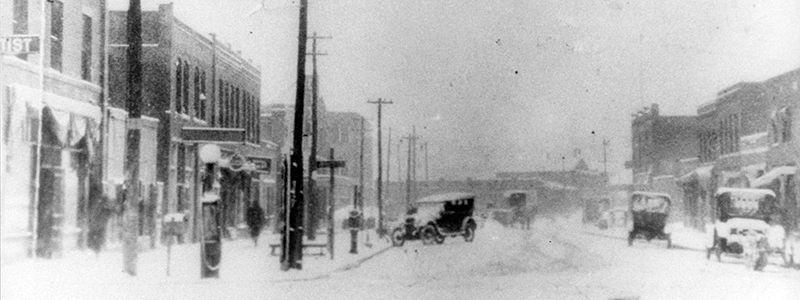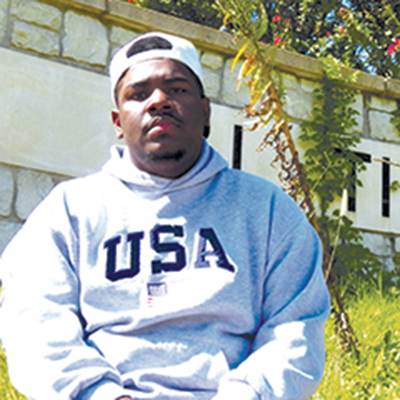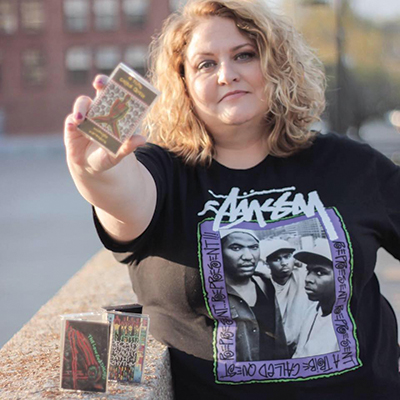The new Black Wall Street
Tulsa’s hip-hop renaissance signals progress in healing the city’s racial divide
Hip-hop Culture begins with the four elements: DJing, breaking, MCing and graffiti. These are its foundation. With those elements, the genre has always aimed at transforming the discordant, often troubling details of a city into art.
Tulsa’s history is rife with such detail. Like many cities, it has always been divided by race. Greenwood, Archer and Pine formed a boundary where racial separation was actually marked by the train tracks. People born here just got used to it. Parallel communities developed in the same city with separate churches and restaurants and even separate music and art. The sides had different names.
In the early 20th century the community to the north of downtown was known as Greenwood, or Black Wall Street. It started in 1906 when a wealthy African American businessman named O.W. Gurley bought 40 acres of land and designated it to only be sold to black investors. At the time, African American property ownership was actively suppressed. Eventually Black Wall Street became the most affluent black community in the nation with more than 100 black-owned businesses, a thriving financial sector, multiple black millionaires and a notable jazz, art, and literary scene—the history of which is respected to this day.
Tragically, on May 31, 1921, Black Wall Street was burned to the ground by an armed mob and members of the Tulsa police department. The Tulsa Race Massacre (still the most violent in American history) was a deliberate attempt to destroy the dream of a prosperous black community in Tulsa.
Yet, despite this tragedy and turmoil, the positive legacy of Greenwood endures. Now, it is the story of a new generation of hip-hop artists and young entrepreneurs poised to rekindle the spirit of Black Wall Street and confront Tulsa’s long segregation with the power of their work.

Steph Simon looks calm even when he’s excited. He’s a 28 year-old Tulsa rapper whose last album, “Visions of the Tisdale,” sounds like a love letter to his city.
“I know people who stay right on the other side of that highway,” Simon said, sitting on Soundpony’s patio, smiling under the brim of a baseball cap and pointing north. “But they’ve never been on this side of the street … They worked at Emerson, and they stay right there and that’s North Tulsa. Just a few hundred feet that way. It’s a whole other thing happening, and the people living there don’t even know this exists. That’s one of the reasons why I feel like we’re out here. We’re like the Christopher Columbus of what’s happening right now. Bringing North Tulsa out here.”
Simon is a member of a growing Tulsa music community still inspired by the history of Black Wall Street, which to him sounds almost like a fairy tale.

“Once you seek out the knowledge of [Black Wall Street], you get a different sense of possibility, a different pride. It feels like a pinnacle. Everybody thriving. It’s hard to imagine something like that existing in a place where I walk everyday.”
In the past few years Simon and his musical collective TulsaXWorld have quietly been helping to reshape the demography of downtown. Another central figure in the TulsaXWorld collective is local businessman, producer, and performer Keenan Lane, aka Keeng Cut. Lane is the co-founder of the popular food truck TNT Wangs.
“We were basically delivering food out of my car for a few years, and we were actually down for awhile,” Lane said. “When we got ready to start up again that truck kind of fell out of the sky for us. It was a real blessing. We owe a lot of people in the community for that.”
After two years in business, TNT Wangs has become a successful mainstay downtown by Cain’s and Soundpony. The menus framing the truck’s window are covered with signature soul food dishes named after local hip-hop heroes, but Keeng Cut’s personal hip-hop vision extends much further than his business aspirations.
Over the last year, the TulsaXWorld collective has started holding regular events under the name World Music Culture.
“We wanted to incorporate older artists like the Outsiders and Oilhouse and Mr. Burns, with younger voices like St. Dominik and Tae Hero,” Lane said. “I think of it as a genre of music that’s become a whole culture. Hip-hop is just part of what’s happening. It’s become so much bigger than just one style of music or one type of group.”
Simon and Lane’s goal is to carry the legacy of Black Wall Street into the here and now, by integrating the music, culture and businesses of the black community into the larger fabric of Tulsa. Simon lists a number of businesses carrying the community forward—New Look Barber Shop, the recently reopened Wanda J’s, Tropical Smoothie.
“Tropical Smoothie is a black-owned business, but it’s not even just black anymore. Like Jake Beeson, the artist and designer. He’s white, and he’s a part of this new Black Wall Street. Now there are white people who are learning about it through the music and the history, and they want to bring it back too.”
Beeson is also a genuine hip-hop head; as a kid in the 90s, he collected Yo! MTV Raps trading cards with pictures of rappers like Big Daddy Kane and Third Bass. His artwork—illustrations of everything from GI Joes and Transformers to Biggie Smalls and Scooby Doo—is a sophisticated tapestry of American pop iconography.
As downtown Tulsa is experiencing something of a renaissance in graffiti art, Beeson and other artists of his ilk are regularly commissioned to tag elaborate murals on the walls of local businesses. Beeson describes himself as a “graffiti writer” for the local graphic design and art company Clean Hands, but others like Scott Phillips, the emcee known as Dr. Freeman, are quick to tout his hip-hop contributions.
“That’s an OG in the art game,” Phillips said. “He’s done cover art for everyone. Donated his time to painting at live events and making fliers and design pieces for people just for the love sometimes. As far as hip-hop guys, I want to surround myself with individuals that encompass the four elements, and I think he absolutely represents that.”
Phillips is one of the founders of a monthly hip-hop celebration, Lessons in Fresh, a full immersion course in the fundamentals of hip-hop, which has featured several of Beeson’s pieces. D.j. Somar, aka Steve Ramos, who founded Lessons along with Phillips, spins an infectious variety of hip-hop classics with contemporary cuts while graffiti artists like Beeson paint live art on the spot. Held at a different location each month (usually at a downtown bar, or a park), there are often breakdancers, battles, and cyphers in what the founders describe as an attempt to recreate “that ol’ skool block party that the culture was founded on.”
“I really enjoy the heyday hip-hop is having now as far as influencing the town,” Phillips said. “Every opportunity that I have to hit the mic with Oilhouse or Lessons in Fresh, that encompasses how I feel about hip-hop. I want to put a voice or a sound to something that Bboys can break to, DJs can scratch to, artists can put in their earbuds when they’re painting … I feel like the city is finally conducive to that.”
This creativity has opened a unique musical and cultural space for Tulsa as various threads of hip-hop converge here in counterintuitive ways.
“It’s not like the Boombap of the East Coast.” Phillips said. “It’s not the Buggalo of the West Coast. You know? Oklahoma is on that Southwestern dirty south vibe to where it’s a mainline to connect everything. I think this combination of so many different styles is what’s made it possible for so many audiences to embrace it now. What we have now is a bigger scene of what used to be underground.”
Phillips also credits local venues for propelling this renaissance—places like Soundpony, The Yeti, Venue Shrine, Vanguard, and others that welcome a diversity in music, experimental shows, and embrace many and varied styles of hip-hop.
“A decade ago there were only a few places, and all of the spots were pretty segregated,” he said. “Shout out to the venues that believed in this. There’s so many places that support the scene now. It’s not just the random club over on Lewis or up north.”
One of the most widely heard voices for hip-hop in Tulsa presently is Ali Shaw. She’s the host of the Weekly Rewind radio show on Tulsa’s KJAMS 105.3, which features a blend of throwback 90s hits and local and underground crossovers.

“I’ve been called Mamma Tulsa by a few rappers,” Shaw said. “It’s not a term I loved at first, but if there’s ever a beef or an argument between people in the scene I try to knock it out completely if I can. I keep trying to bring everything back to love. That’s probably where the name came from. So I’ve started trying to embrace it.”
Shaw is an unlikely a character to fit into the story of Tulsa hip-hop. A white, single mother from the small town of Lexington, Okla., Shaw comes from a culture slow to embrace hip-hop or black culture broadly.
“I didn’t really have a lot of access to hip-hop growing up. One of the first things I got was a tape a friend made me. It had A Tribe Called Quest’s album The Low End Theory on one side, and Heavy D.’s album Peaceful Journey on the other. I heard that tape, and I pretty much lost my mind. I just had that feeling that I wanted to be a part of this.”
For the last six years Shaw has cultivated a climate of real hip-hop love on her show, spreading a reverence for celebrated icons and local newcomers alike. Ironically, Shaw’s background kept her fairly removed from the legacy of Greenwood.
“I will tell you that I did not know anything about Black Wall Street until I went to school at Tulsa Community College,” she said. “I’m from Oklahoma, and I never even heard of it. I hate to even talk about it sometimes because it infuriates me. I only learned about it because I enrolled in an African American history class. I remember sitting in my seat and thinking I may be sitting in a place where some of this violence actually happened … Then when I learned about Black Wall Street it was just incredible. I loved to hear about all the businesses that were flourishing, to hear about the way people dressed, the art and the culture.”
Shaw sees a Tulsa where the possibility of unity is still alive—and her optimism is proving to be founded. “It feels like people are working together finally. It’s like a sense of Black Wall Street is trying to make its way back, kind of reincarnating itself. The way people in the community have started trying to join forces. Maybe it’s that feeling that if we’ve done this before maybe we can do it again.”
A recent Forbes article called Tulsa the number one city in America for young entrepreneurs to live, but the vast economic development of the last decade seems to have stopped once again at the train tracks at Archer and Pine—for all of downtown’s growth, north Tulsa still doesn’t even have a grocery store (meanwhile, there are four within less than a square mile of each other on Brookside). So much of this city’s cultural attention and affluence lives on the south side of those tracks.
Dan Hahn, local rapper and principal of the chartered Tulsa School of Arts and Sciences, describes the problem as he sees it—in the insecure position of being able to improve, or devolve, quickly.
“I feel like downtown especially in the Brady District, is in a very precarious place,” Hahn said. “Ten years ago the problem was trying to make downtown a place that people from south Tulsa wanted to drive to. Now the question is how can we keep it from becoming something awful as so many urban centers do? How can we get people to care about each other’s lives with no currency attached?”
The tragic death of Terence Crutcher, an unarmed black man shot by Tulsa Police Officer Betty Shelby on September 16, may have signaled a shift for Tulsa. National media descended on the city, anticipating the type of violence and unrest that has plagued this nation in recent months. It never happened. There was no rioting, or looting. Instead, a community of hurting people—black, white, brown—found solace in unity, in each other, and grieved.
Local poet and performer Written Quincy likes to say, “I believe in spirits, phantoms, and ghosts. There are places in downtown Tulsa where the ground is unsettled, and if I’m going to speak it needs to be with their voices.”
Perhaps the legacy of Black Wall Street is the sound of those voices and a city that needs, simply, to listen. Are we listening?
For more from Damion, read his profile of Brandee Hamilton.


.jpg)
.jpg)
